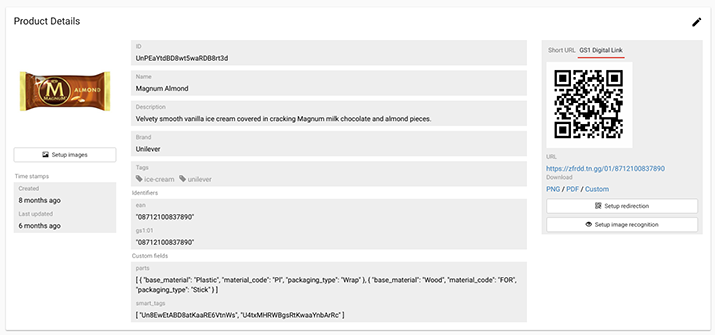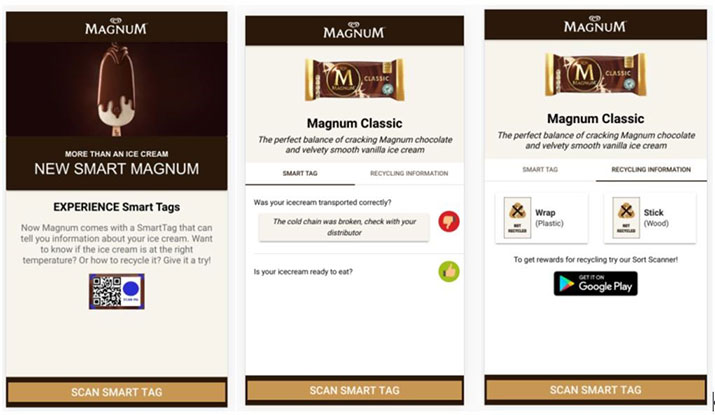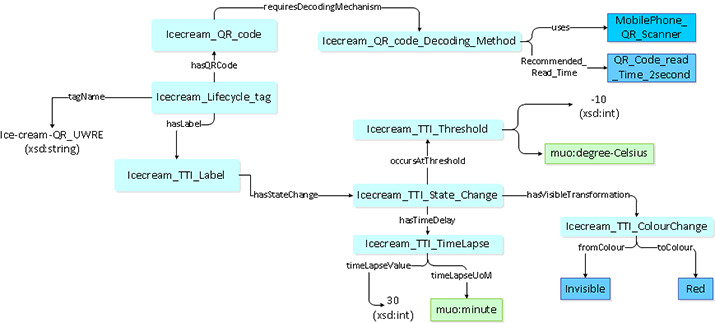SmartTags-enabled Fast-Moving Consumer Goods: Creation and Management
New types of sensors that are printable and can collect, sense, and read environmental parameters of relevance to the product and its use are becoming reality. For fast-moving consumer goods (FMCG) this represents the basis for the creation of a new generation of supply chains which, in combination with GS1 Digital Link global specifications standard, makes it possible to identify each product item, track it and monitor it on an item level.
These capabilities offer opportunities for informed management of assets and innovative consumer engagement by transforming consumer goods into digital assets. The TagItSmart [1] project funded by the Horizon 2020 EU research program, has researched and piloted the use of QR-codes printed with functional inks and printed NFC (Near Field Communication) tags with sensing capabilities to create ‘SmartTags’. The project made solid ground on the research topic and development of the SmartTag technology, which is, because of its simplicity and standardized approach, adopted and used by many industry players.
Environment-reactive SmartTags with Functional Inks
With NFC and RFID (Radio Frequency Identification) solutions proving expensive for consumer-packaged goods, TagItSmart has pioneered the use of dynamic QR-codes that are printed on consumer goods using environmentally reactive inks that change appearance according to selected conditions, e.g. temperature, humidity, light intensity. The growing use of smartphones equipped with cameras facilitates an off-the-shelf solution for scanning the dynamic QR-code information as well as lifecycle tracking of the item through seamless observation measurements of the generated smart tag data. This visual change on the product packaging, as well as individual product identification using the GS1 Digital Link Standard [2] allows not only tracking of every individual item from the factory to recycling, but also enables additional information about the item to be communicated to consumers. This includes visual clues to consumers that a product is at its optimum consumption temperature, monitoring of condition-sensitive goods during transport (e.g. vaccines, meat, and dairy goods), alerts to retailers that an item is close to its best-before date, and also if an item has been properly recycled. In a nutshell, this opens up exciting possibilities for consumer engagement, supply chain tracking, and product recycling.
Service Platform for SmartTags Management
The ecosystem around such SmartTags-enabled FMCG is driven by the TagItSmart service platform that includes semantic models for capturing the characteristics of the SmartTags and reusable semantically enabled workflows for their creation and management. The platform includes SmartTags (either QR-codes with functional inks or NFC tags) which augment products or physical entities with sensing capabilities and allow their virtualization as virtual entities for monitoring the product lifecycle.
The approach uses semantic repositories for modeling the physical world objects as virtualized entities as well as users of the platform, together with their contextual information and location to enable internal or external services to be composed. The resulting workflows are the result of a composition process which starts on a service template front-end, exploiting the well-known Node-RED wiring tool, involves a service manager which oversees resolving service parameters semantically, based on a context (e.g. users and locations) and outputs a fully-fledged workflow execution engine based on AWS Lambda instances in charge of enforcing the service composition and hereafter handling the requests in an efficient and scalable fashion. The solution has been implemented in Node.js and empowers users to deploy new services, virtualizing the Internet of Things real-world objects such as industry FMCG in their consumer-oriented ecosystems from production to recycling. This Composition-as-a-Service (CaaS) approach is smart, efficient, and fully customizable with any service. It allows the definition of on-the-fly new service functions and to put them in line in the execution chain or handle service unavailability or errors in the composition process in a user-friendly and verbose fashion. The end-to-end workflow in the service platform is illustrated below with an example of the Magnum ice cream use case developed in TagItSmart, which implemented a smart, environmentally reactive packaging solution as well as an end-user experience application.
SmartTag-enabled Ice Cream
The TagItSmart technology can be showcased in numerous scenarios, with an ice cream scenario being noteworthy, due to the possibility to showcase most of the SmartTag’s technology benefits. An irreversible functional ink is used to create the SmartTag, capturing temperatures larger than −10 °C with a timestamp set to 30 minutes. The sensing capability of the SmartTag, supported by the ink, is specifically designed for the ice cream scenario to satisfy specific requirements, as shown in Fig. 1:

Figure 1: Ice cream SmartTag environment parameter definition.
The SmartTags are encoded with a QR code to identify and encode the temperature-sensitive property and an image to show the user that the ice cream is good to be consumed. Next, a mobile phone with a web browser is selected as the scanner for the SmartTag. The identifiers for the designed SmartTags are created and the resulting tags are printed.
The next step is to model the objects that will be labeled with the SmartTags, i.e. the ice cream virtual entity, which is achieved through a VE-front end in the platform (Fig. 2). The front end is driven by the VE semantic model (detailed in [3]).

Figure 2: Application front end for describing the Ice cream VE.
The user experience with the SmartTags is also an important part of the application development process. It will typically involve how the user is going to scan the SmartTag and how the information generated is going to be used and presented. This is developed as a Web application and integrates the mobile phone scanner and application workflow through the correspondent SDKs and libraries, as shown in Fig. 3.

Figure 3: The Magnum user experience application.
To ensure the smooth creation of the tags, the TagItSmart project created a semantic model for describing the environment-reactive properties of the QR codes and NFC electronic tags. The model incorporates the materials’ composition of the physical products, the characteristics of the functional ink, such as what environmental conditions it reacts to (e.g. temperature, humidity, time-lapse, etc.), the accompanying relevant state changes (e.g. color and visibility changes), as well as observation measurements together with their spatial description. The semantic model is detailed in [4] and the instantiation of the SmartTag for tracking the ice cream lifecycle is shown in Fig. 4.

Figure 4: Semantic instantiation of SmartTag for ice cream lifecycle tracking.
The semantic model guides the selection of the required functional ink for the QR code to be printed, based on what environment parameter needs to be monitored, together with the identification of the thresholds and tolerance levels.
References
- H2020 TagItSmart Project, Grant Agreement 688061. https://bit.ly/3n7saIy.
- Digital Link GS1 Standard. [Online]. Available: https://bit.ly/2U4ssDd
- "D4.1. Resource and Service Modelling Specification," in "TagItSmart Public Deliverable," TagItSmart! Smart Tags driven service platform for enabling ecosystems of connected objects, 2017. [Online]. Available: https://bit.ly/36gwRsz
- N. Gligoric et al., "SmartTags: IoT Product Passport for Circular Economy Based on Printed Sensors and Unique Item-Level Identifiers," Sensors, vol. 19, no. 3, 2019.
 Suparna De is a Senior Lecturer in Computer Science and Networks at the University of Winchester, UK. She obtained her Ph.D. in Electronic Engineering from the University of Surrey. She led the work on developing semantic models for capturing the characteristics of the Smart Tags and to provide decision-support mechanisms for connecting their lifecycle data to semantically enabled workflows in the H2020 TagItSmart project. Her research interests include large-scale data analytics in Web of Things scenarios, machine learning, social computing, and Semantic Web technologies.
Suparna De is a Senior Lecturer in Computer Science and Networks at the University of Winchester, UK. She obtained her Ph.D. in Electronic Engineering from the University of Surrey. She led the work on developing semantic models for capturing the characteristics of the Smart Tags and to provide decision-support mechanisms for connecting their lifecycle data to semantically enabled workflows in the H2020 TagItSmart project. Her research interests include large-scale data analytics in Web of Things scenarios, machine learning, social computing, and Semantic Web technologies.
 Nenad Gligoric is one of the pioneers of the IoT scene in Serbia, working as a software engineer in Ericsson and as a project manager in DunavNET on more than 10 EU, FP7 and H2020 projects. He was one of the technical managers of the H2020 TagItSmart project.
Nenad Gligoric is one of the pioneers of the IoT scene in Serbia, working as a software engineer in Ericsson and as a project manager in DunavNET on more than 10 EU, FP7 and H2020 projects. He was one of the technical managers of the H2020 TagItSmart project.
Sign Up for IoT Technical Community Updates
Calendar of Events
IEEE 8th World Forum on Internet of Things (WF-IoT) 2022
26 October-11 November 2022
Call for Papers
IEEE Internet of Things Journal
Special issue on Towards Intelligence for Space-Air-Ground Integrated Internet of Things
Submission Deadline: 1 November 2022
Special issue on Smart Blockchain for IoT Trust, Security and Privacy
Submission Deadline: 15 November 2022
Past Issues
September 2022
July 2022
March 2022
January 2022
November 2021
September 2021
July 2021
May 2021
March 2021
January 2021
November 2020
July 2020
May 2020
March 2020
January 2020
November 2019
September 2019
July 2019
May 2019
March 2019
January 2019
November 2018
September 2018
July 2018
May 2018
March 2018
January 2018
November 2017
September 2017
July 2017
May 2017
March 2017
January 2017
November 2016
September 2016
July 2016
May 2016
March 2016
January 2016
November 2015
September 2015
July 2015
May 2015
March 2015
January 2015
November 2014
September 2014


